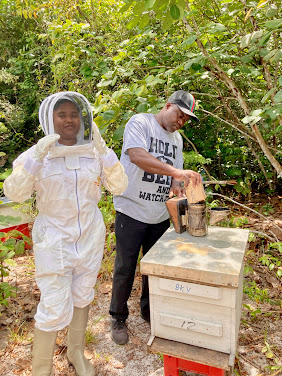The following blog post comes from Robert Spencer, Alabama Cooperative Extension personnel and repeat Farmer to Farmer volunteer, who writes about his past week in Haiti:
 |
| Robert and producer in La Coline inspect teeth to determine age of buck |
The first five years of my visits to Haiti have primarily focused on meat quality and food safety as it relates to rabbit production and processing; much of is based on HACCP guidelines. During the past year (year 6) I have added production quality, or as I call it “Animal Welfare”, to my subject matter. This topic was the result of my realization that producers lacked a basic understanding of production essentials in regards to caring for their animals. Based on my observations, I decided to focus on specific areas including nutrition (vegetation, feed, and water), care of newborn, shade and protection from harsh environmental conditions, sanitation, and more. I felt this area was more important knowing that without quality production, producers will not have adequate numbers for processing and marketing.
 |
| Robert and Anderson train La Coline producers in animal welfare |
It was obvious there were health and mortality problems, much of which could be attributed to poor nutrition, dirty or no water, direct exposure to elements and heat stress, poor sanitary conditions (dirty cages and accumulation of manure and urine under cages), and no shelter for newborn rabbits. I also realized much of this applied to other forms of livestock, including poor nutrition (limited access to forage), inadequate access to water, continuous exposure to sun, and etc. My theory is, as producers develop basic production quality skills, from there they can move forward with better results.
The first week of my visits included the following regions and communities: South: Riviere Froide, Southwest: La Coline and Passe Bois D’orme. The purpose of the visit to La Coline was to address meat goat production, in Passe Bois D’orme the area of focus was marketing of rabbits, and in Riviere Froide we delivered rabbits and talked about basic considerations for rabbit production. This was my first time to address meat goat production in Haiti, but it is one of my areas of specialty. The people in La Coline were eager to discuss this topic so we had a good time interacting. The rabbit producers in Passe Bois D’orme have an impressive inventory of rabbits, but lack in marketing ideas, so Anderson Pierre [F2F Field Officer] and I spent a significant amount of time sharing ideas with them. The special needs school in Riviere Froide is new to rabbit production, we delivered thirty-four rabbits and conducted an educational workshop. The next day we returned to build rabbit cages, then distribute cages and rabbits to those who had attended previous trainings.
 |
| Women in Riviere Froide receive rabbits and cages |
I always enjoy my visits to Haiti, and working with the Farmer to Farmer staff. They are like family to me, and I consider Haiti my second home. Everywhere I visit the people are so friendly and receptive to trainings. These factors keep me motivated with return visits and striving to improve situations through education and encouragement. As producers’ abilities to understand quality of production increases, and their desire to apply this knowledge increases, their animals will remain healthy and more productive, thereby leading to increased inventories, whereby they can start thinking about best management practices for processing and marketing. This has remained my primary area of focus for almost a year, and as I revisit communities from previous trainings I see results and hear testimonials regarding improved situations and increased production.




.png)

Comments
Post a Comment